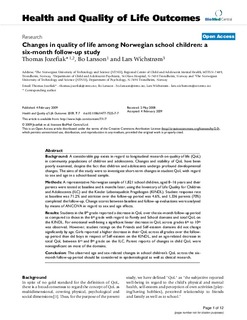| dc.contributor.author | Jozefiak, Thomas | |
| dc.contributor.author | Larsson, Bo Sture | |
| dc.contributor.author | Wichstrøm, Lars | |
| dc.date.accessioned | 2015-09-29T12:34:49Z | |
| dc.date.accessioned | 2015-10-20T11:58:33Z | |
| dc.date.available | 2015-09-29T12:34:49Z | |
| dc.date.available | 2015-10-20T11:58:33Z | |
| dc.date.issued | 2009 | |
| dc.identifier.citation | Health and Quality of Life Outcomes 2009, 7 | nb_NO |
| dc.identifier.issn | 1477-7525 | |
| dc.identifier.uri | http://hdl.handle.net/11250/2357228 | |
| dc.description.abstract | Background: A considerable gap exists in regard to longitudinal research on quality of life (QoL) in community populations of children and adolescents. Changes and stability of QoL have been poorly examined, despite the fact that children and adolescents undergo profound developmental changes. The aims of the study were to investigate short-term changes in student QoL with regard to sex and age in a school-based sample.
Methods: A representative Norwegian sample of 1,821 school children, aged 8-16 years and their parents were tested at baseline and 6 months later, using the Inventory of Life Quality for Children and Adolescents (ILC) and the Kinder Lebensqualitat Fragebogen (KINDL). Student response rate at baseline was 71.2% and attrition over the follow-up period was 4.6%, and 1,336 parents (70%) completed the follow-up. Change scores between baseline and follow-up evaluations were analysed by means of ANCOVA in regard to sex and age effects.
Results: Students in the 8(th) grade reported a decrease in QoL over the six-month follow-up period as compared to those in the 6(th) grade with regard to Family and School domains and total QoL on the KINDL. For emotional well-being a significant linear decrease in QoL across grades 6(th) to 10(th) was observed. However, student ratings on the Friends and Self-esteem domains did not change significantly by age. Girls reported a higher decrease in their QoL across all grades over the follow-up period than did boys in respect of Self-esteem on the KINDL, and an age-related decrease in total QoL between 6(th) and 8(th) grade on the ILC. Parent reports of changes in child QoL were nonsignificant on most of the domains.
Conclusion: The observed age and sex-related changes in school children's QoL across the six-month follow-up period should be considered in epidemiological as well as clinical research. | nb_NO |
| dc.language.iso | eng | nb_NO |
| dc.publisher | BioMed Central | nb_NO |
| dc.title | Changes in quality of life among Norwegian school children: a six-month follow-up study | nb_NO |
| dc.type | Journal article | nb_NO |
| dc.type | Peer reviewed | en_GB |
| dc.date.updated | 2015-09-29T12:34:49Z | |
| dc.source.volume | 7 | nb_NO |
| dc.source.journal | Health and Quality of Life Outcomes | nb_NO |
| dc.identifier.doi | 10.1186/1477-7525-7-7 | |
| dc.identifier.cristin | 356259 | |
| dc.description.localcode | © 2009 Jozefiak et al; licensee BioMed Central Ltd. This is an Open Access article distributed under the terms of the Creative Commons Attribution License (http://creativecommons.org/licenses/by/2.0), which permits unrestricted use, distribution, and reproduction in any medium, provided the original work is properly cited. | nb_NO |
